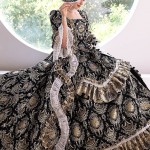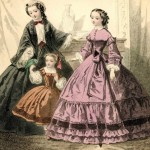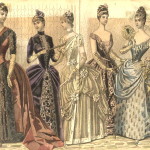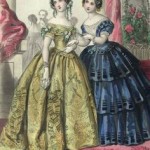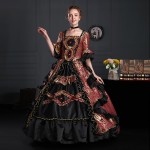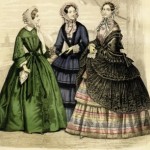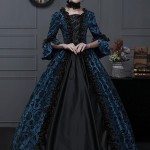
historical victorian era women fashion
Get Know The Victorian Era
During the Victorian era, women’s fashion underwent significant changes. Queen Victoria’s reign from the mid-19th century to the early 20th century was a time of strict social norms and conservative values, which were reflected in women’s clothing.
In the earlier years of the Victorian era, women’s clothing was relatively plain and conservative, with long dresses and a loose fitting blouses made of cotton or silk. Skirts were usually floor-length and had a fullness to them, while bodices were often boned and structured to create a shape. Collars and cuffs were often starched and decorated with lace or ribbon.

Victorian Era Fashion
Later in the Victorian era, fashion became more elaborate, with intricate details and embroidery. Skirt widths increased, and petticoats became an essential layer to create fullness and volume. Women often wore multiple petticoats, each of a different size and shape, to achieve the desired look. Petticoats were usually white or ivory and could be made of cotton, silk, or even steel to provide structure and support.
Footwear also changed during the Victorian era, with women wearing closed-toe shoes called “pumps” or “slippers” made of leather or velvet. Heels were often low, and shoes were decorated with bows or lace.
Overall, Victorian women’s fashion was conservative and reflect the era’s values of modesty and decorum. Fashion trends changed over time, but women’s clothing remained relatively structured and formal throughout the Victorian era.
Get Know the Victorian Era Dresses
Victorian dresses are often associated with a formal and traditional style, often featuring intricate details and embellishments. Here are some common characteristics of Victorian-style dresses:
- 1.Floor-length length: Victorian dresses were typically ankle-length or floor-length, often with trains attached to the back or sides. This length gave a sense of dignity and formality to the dress.
- 2.Full skirts: Victorian dresses often had very full skirts, with layers and layers of petticoats to create a bell-shaped appearance. The skirts were often adorned with ruffles, lace, or embroidery.
- 3.Necklines: Victorian dresses often had very low necklines, often with long sleeves or lace-covered shoulders. This style showcased the shoulders and décolletage, which was considered very feminine and alluring.
- 4.Intricate details: Victorian dresses were known for their intricate details and embellishments, often using lace, ribbons, bows, buttons, and other embellishments to decorate the dress. The details were often very fussy and delicate, adding a touch of romance and femininity to the look.
- 5.Silhouette: Victorian dresses often had a very distinct silhouette, with a waistline that was either very low or non-existent. The skirts flowed out from the waistline, creating a distinct hourglass shape.
- 6.Laces and buttons: Laces were often used as a detailing for Victorians, adding a touch of classy element to the overall look. Buttons were also a common feature on men’s suits, waistcoats, and outerwear, while women’s dresses often had buttons on the front paneling to create a clean and tidy appearance.
- 7.Jewelry: Victorians often wore chunky gold chains, brooches, necklaces, and bracelets with their dresses, which added a touch of classy element to the overall look.
- In conclusion, Victorian-style dresses are typically associated with formal occasions, royalty, and a traditional style that is both romantic and feminine.
- Development of Victorian Fashion Do you know Victorian fashion ? Do you know Victorian costumes how to development?
- The Crinoline or Hoop Skirt for Victorian Dresses 1850s 1860s 1870s 1880s 1890s Petticoat Crinoline
- Victorian Dresses Ball Gowns- 1844-48 History of 1840s Victorian Ball Gown
- 19th Century Victorian Fashion – 1840s to 1890s History of 19th Century Victorian Women Fashion Dress
- Victorian Era Women Dresses History of Victorian Style Dresses Ball Gown 1830s-1890s
- Where to buy Victorian Dresses Buy Authentic Historical Victorian Dresses
- where can I buy queen victoria’s wedding gown? 17th 18th Century Victorian Wedding Gowns
- How to make a Victorian Dress? Create a Victorian-style dress
- Why were Victorian era dresses so big? The petticoats culture of Victorian fashion
- How did women dress in the Victorian era ? Victorian era fashion underwent significant changes

